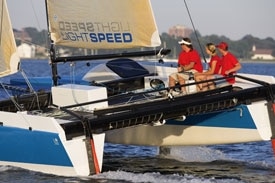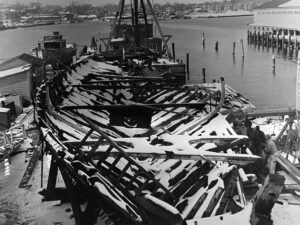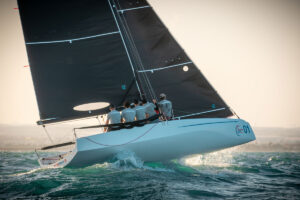
Lightspeed
In a few years, the Lightspeed 32 (LS32) may be a thriving new one-design catamaran class. Today, however, the only one in existence is out of the water at the Newport Shipyard, undergoing repairs to a minor stress fracture sustained to its starboard hull during the Newport Unlimited Regatta on Saturday.I guess that’s why they call it a prototype.Before the Marc van Peteghem and Vincent Lauriot Prevost-designed carbon-nomex rocketship goes into production, Lightspeed president Hunt Stookey and vice president of sales Stan Schreyer are putting the boat through extensive sea trials on Narragansett Bay. I was lucky enough to ride along for the most recent test, and witnessed the LS32 perform in a variety of conditions, from light and spotty to full-on breezy-all in the course of one and a half races on Saturday morning. Aside from the thrill of sailing faster than the wind speed, I enjoyed watching Stookey and Schreyer tweak their new toy. The LS32’s mainsail requires an unexpected amount of luff tension, so the pair discussed ways to improve the cunningham purchase system. And because the Unlimited Regatta was the boat’s buoy racing debut, every maneuver that had seemed so effortless in the open water now had to be compressed to fit within the confines of the racecourse. Do you raise the roller-furling asymmetrical while approaching the windward mark, or do you wait until after you turn the corner? How do you prepare for a clean jibe when the spinnaker winches are mounted 18 feet apart?Of course, these adjustments and considerations come into play on any boat. But when the boat is one-of-a-kind and you’re sailing it around the buoys for the first time, there are a lot more adjustments to be made. “I’ve got a long to-do list,” said Schreyer, “and it’s not getting any shorter.”We all know it’s beneficial to learn from our mistakes, but rarely do we set out to make mistakes in order to learn something. And that’s more or less what Stookey and Schreyer have been doing for the last six weeks. “Each time we sail, it’s a process of finding the weakest link,” Stookey explained. “Once we find the weakest link, it exposes the next weakest link-that’s what happens, fundamentally.”So when, halfway up the second beat of the second race, as we were flying a hull on starboard tack, a high-stress section of the hull began to crack, Stookey’s only real disappointment was that he had to drop out of a race he was leading. “We’ve been really lucky so far in that every problem we’ve discovered has been relatively minor,” said Stookey. “The big thing is, we’re feeling really good about the design of the boat-the balance is good, the rig is right. There are things to adjust, but they’re just normal teething pains.”Like any infant, Lightspeed demands the utmost patience from its caretakers, and Stookey and Schreyer don’t shy from the task. They take a positive view of the development process, reasoning that it’s better to repair hull No. 1 than to repair hulls No. 1 through No. 30. Still, it’s too bad we couldn’t finish the race-the Lightspeed is hungry for its first bullet.









